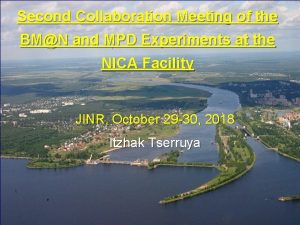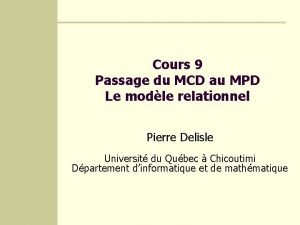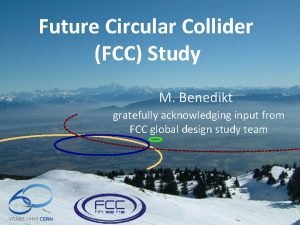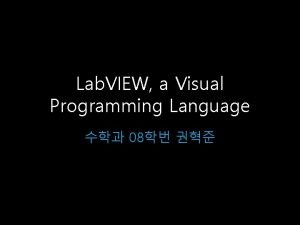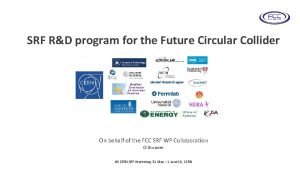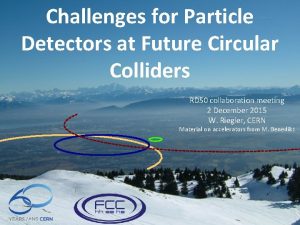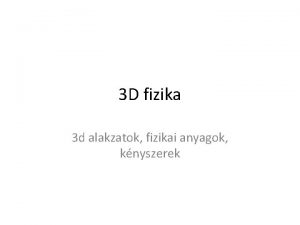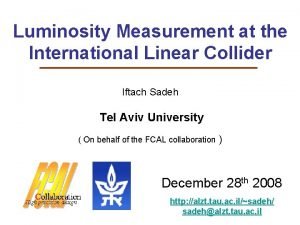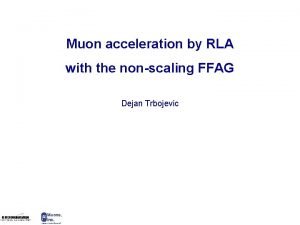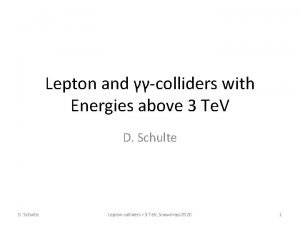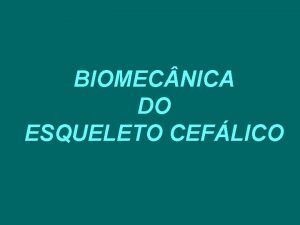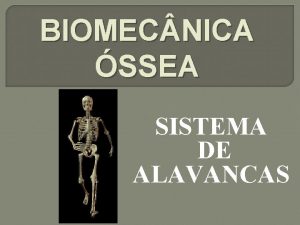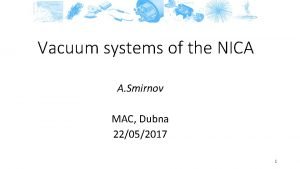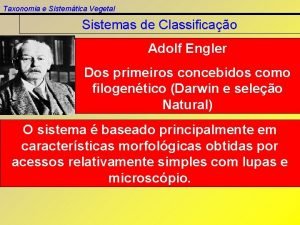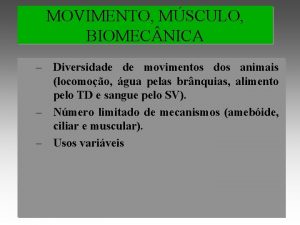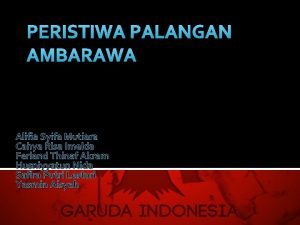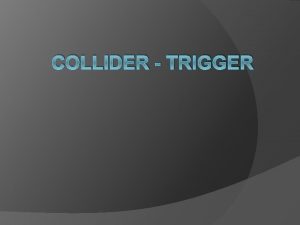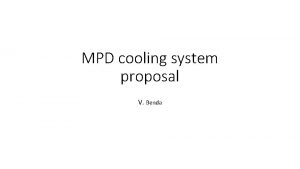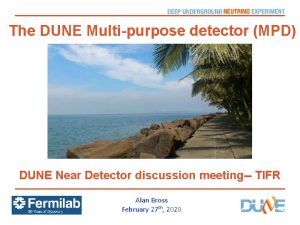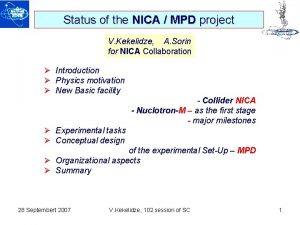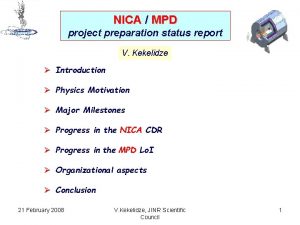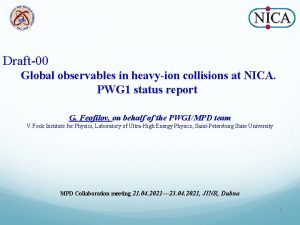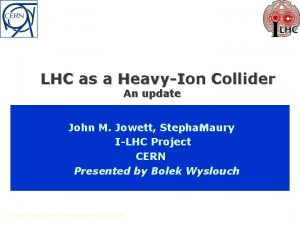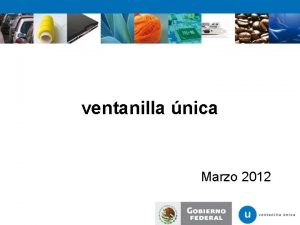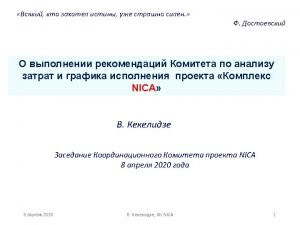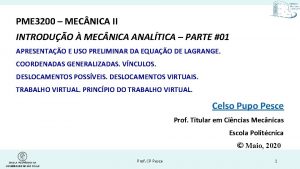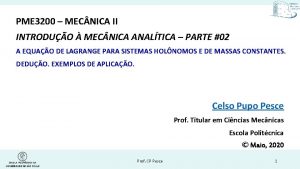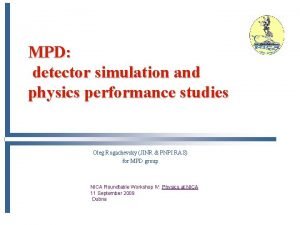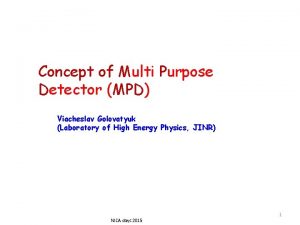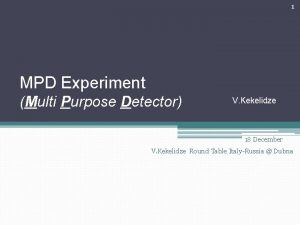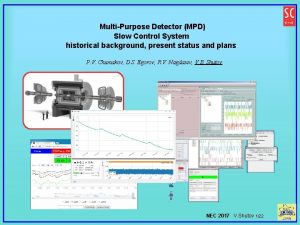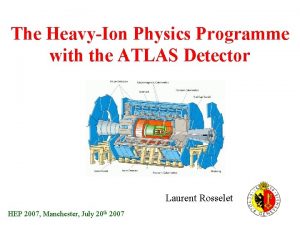The MPD detector for the NICA heavyion collider

























- Slides: 25

The MPD detector for the NICA heavy-ion collider at JINR (concept) V. I. Kolesnikov JINR, Dubna On behalf of the NICA/MPD Collaboration The 12 th Vienna Conference on Instrumentation February 15 -20, 2010, Vienna, Austria

Outline Accelerator complex NICA Physics program MPD spectrometer concept Conclusion & Outlook V. I. Kolesnikov, VCI 2010

Nuclotron-based Ion Collider f. Acility NICA advantages: energy range s. NN = 3 -11 Ge. V is optimal for physics of strongly interacting matter rich nomenclature of colliding systems (from p+p to Au+Au) high luminosity (up to 1027) allows very detailed energy scan New flagship project at JINR, Dubna, Russia Based on the technological development of the Nuclotron facility Optimal usage of the existing infrastructure Modern machine which incorporates new technological concepts gain in luminosity First beams expected in 2015

NICA complex The Multi. Purpose Detector is proposed for study of hot and dense baryonic matter in collisions of heavy ions over mass range A=1 -197 at a centre-of-mass energy √s. NN = 3 -11 Ge. V. Booster 2. 109 ions/bunch E/A = 608 Me. V Q=+32, electron cooling MPD Nuclotron E/A = 1. . 5. 5 Ge. V Q=+79 SPD Collider Beams – p, d(h). . 197 Au 79+ Collision energy – 3 -11 Ge. V No bunches – 2 x 17 Luminosity: 1027 cm-2 s-1(Au), 1032 (ph) Interaction points – 2 (MPD and SPD detectors) V. I. Kolesnikov, VCI 2010 Ion source+Linac 2. 109 ions/pulse E/A = 6. 2 Me. V Q = +32

NICA Collaboration Budker INP ü ü ü Booster RF system Booster electron cooling Collider RF system Collider SC magnets (expertise) HV electron cooler for collider Electronics All-Russian Institute for Electrotechnique HV Electron cooler GSI/FAIR SC dipoles for Booster/SIS-100 SC dipoles for Collider IHEP (Protvino) Injector Linac FZ Jűlich (IKP) HV Electron cooler Stoch. cooling Fermilab HV Electron cooler Stoch. cooling BNL (RHIC) Electron & Stoch. Cooling ITEP: Beam dynamics in the collider Corporation “Powder Metallurgy” (Minsk, Belorussia): Technology of Ti. N coating of vacuum chamber walls for reduction of secondary emission V. I. Kolesnikov, VCI 2010

NICA physics. QCD phase diagram The most intriguing and unexplored region of the QCD phase diagram: § characterized by the highest net baryon density § detailed information about properties of the phase transition region can be deduced § strong discovery potential: a) Critical End Point b) Chiral Symmetry Restoration § very attractive for heavy-ion community: RHIC/BNL, SPS/CERN, FAIR/GSI, NICA/JINR Challenge: comprehensive experimental program requires scan over the QCD phase diagram by varying collision parameters : system size, beam energy and collision centrality V. I. Kolesnikov, VCI 2010

NICA Physics. Phase transition Anomaly in hadron production in the same energy range! CERN/SPS NIC A System of maximal net baryon density is created in HI collisions at NICA energies optimum for the compressed nuclear matter exploration 1 st order phase transition? Co-existence of partonic and hadronic degrees of freedom (mixed phase)? Goal: to establish the onset of the observed signatures Program: • energy scan • system size scan Hadronic observables! V. I. Kolesnikov, VCI 2010

NICA Physics. Chiral Symmetry Restoration Change in spectral function of vector mesons in HI CSR signal dielectrons are penetrating probes directly connecting to CRS in-medium modification of vector meson properties PLB 666 (2008) 425 Strong enhancement of low-mass e+e- pairs in A+A (factor of ~ 2. 5) (0. 2<minv<1. 1 Ge. V/c 2) No enhancement in p+p nor in p+A No measurement between 3 -8 Ge. V yet! NICA’s energy range very well suited to fill an important niche: Unveil the onset of the low-mass pair enhancement. Systematic studies of p. A collisions Study pair enhancement under highest baryon density conditions Main experimental challenge: large combinatorial background. Powerful electron PID and good mass resolution (~2%) required. Dileptons are of interest! V. I. Kolesnikov, VCI 2010

NICA Physics. QCD Critical End Point (CEP) Lattice QCD calculations predict the existence of CEP (1 st order phase transition ceases at CEP crossover) But, poor predictions from theory for CEP location (m~180 -500 Me. V, s. NN~5 -20 Ge. V) Method: fluctuation pattern of experimental observables (<pt>, multiplicity, athimuthal distributions, particle ratios, net-baryon number, etc. . ) are very sensitive to the proximity of the CEP, so non-monotonic variation of non-Gaussian moments with beam energy may serves as a signature for CEP. Challenge: detector with large and uniform acceptance (close to 4 , total f-coverage) having good tracking and PID performance in the whole phase space. … and other observables ØEnhanced multi-strangeness production (hyperons) Ø Direct g’s the best probe for the early stage matter! Ø Collective effects, i. e. identified particle flow Ø Multi-particle correlations to measure : g, hadrons, multistrange hyperons V. I. Kolesnikov, VCI 2010

Basic requirements to the apparatus Physics Observables Deconfinement particle yields (g, , K, p, L, Q, W, fragments), flow Critical point fluctuations & correlations of identified particles Chiral phase transition dilepton (e+e-) Challenges: Vast nomenclature of colliding systems – from p+p to Au+Au simultaneous observation of a variety of phenomena Small effects over large kinematical range, sensitivity to acceptance constrains (‘correlations & fluctuations’ studies) Pattern recognition in high track multiplicity environment Detector requirements: Large homogenous acceptance : 2 in athimutal angle, |h|<3, 0. 1<pt<3 Ge. V/c High efficient 3 -D track reconstruction powerful PID: /K up to 1. 5 Ge. V/c, K/p up to 2. 5 Ge. V/c ECAL for g, e High resolution vertexing with low pt ID, two track resolution ≤ 100 mm Excellent perfomance in V 0 (and cascades) reconstruction careful event characterization: impact parameter & event plane reconstruction high event rate capability up to ~ 6 k. Hz V. I. Kolesnikov, VCI 2010

MPD Apparatus ZDC Magnet 0. 5 T Active volume: 5 m (length) 5 m (diameter) ECAL TOF barrel TOF endcap Beam Pipe TPC Inner tracker FD Endcap tracker BBC ZDC V. I. Kolesnikov, VCI 2010

MPD Apparatus : dimensions & coverage Acceptance (B=0. 5 T): Full azimuthal IT (|h|<2. 5) TPC (|h|<2) TOF (|h|<3) ECAL (|h|<1. 2) BBC (1. 5<|h|<4. 5) FD (2<|h|<4) ZDC (|h|>3) V. I. Kolesnikov, VCI 2010

Detector requirements (2) Au+Au collisions: multiplicities & spectra Au+Au (Ur. QMD) s. NN = 9 Ge. V p/K separation below 1. 5 Ge. V/c (realistic limit) Eg < 2 Ge. V, Ng < 600 > 95% (|h|<1) > 65% (1<h<2. 5) V. I. Kolesnikov, VCI 2010

PID methods in MPD (hadrons+e) PID method: Time Of Flight PID separation : e/h – 0. 1. . 0. 35 Ge. V/c /K – 0. 1. 5 Ge. V/c K/p – 0. 1. . 2. 5 Ge. V/c Challenge: overall resolution < 100 ps, good start detector PID method: Ionization loss (d. E/dx) PID separation: e/h – 1. 3. . 3 Ge. V/c /K – 0. 1. . 0. 6 Ge. V/c K/p – 0. 1. 2 Ge. V/c Challenge: resolution better than 8%, combined PID for the crossover regions V. I. Kolesnikov, VCI 2010

Time Projection Chamber Challenges: low material budget (especially in forward direction) high event rates (up to ~6 k. Hz) small distortions, stable conditions in long runs UV laser for calibration & alignment TPC parameters Size: 3. 4 m (length) x 2. 2 m (diameter) Drift Length: 150 cm # of samples: 50 Electric field: 140 V/cm Magnetic field: 0. 5 T (max. ) Gas: 90% Argon + 10% Methane (atm+2 mbar) Readout: 2 x 12 sectors (MWPC+pads or GEM) Pad size – 4 x 10 mm in inner sector area 6 x 12 mm in outer sector area Total # of pads: ~80000 Performance required (MWPC option): Spatial resolution: srf~300 mm sz~ 2 mm Two track resolution < 1 cm Momentum resolution Dp/p < 3% (0. 2<p<1 Ge. V/c) d. E/dx resolution < 8% More details on MPD TPC see poster by V. Babkin (session B) V. I. Kolesnikov, VCI 2010

Inner Tracker 4 cylindrical & disk layers 300 mm double-sided silicon microstrip detectors, pitch - 100 mm Thickness/layer ~ 0. 8% X 0 Barrel: R=1 -4 cm, coverage |h|<2. 5 806 sensors of 62 x 62 mm 2 Disks: under optimization resolution: σz = 120 mm, σrf = 23 mm V. I. Kolesnikov, VCI 2010

Inner Tracker (optimization) IT design optimization tasks (ongoing): best topology in terms of occupancy, event vertex resolution, performance of V 0 and cascades reconstruction Occupancy (several models) – 10% for the inner-most layer, h=0, s. NN = 9 Ge. V TPC alone simulation TPC+IT No PID V. I. Kolesnikov, VCI 2010

Time Of Flight System Basic requirements: Coverage: > 30 m 2, |h|<3 (barrel+endcap) s ~ 80 ps (100 ps overall) Resistive Plate Chambers Dimensions: barrel: 5 m (length), 2. 5 m (diameter) endcap: 2 x 2. 5 m (diameter ) disks Gas: 90% C 2 H 2 F 4 + 5% i. C 4 H 10 + 5% SF 6 Segmentation (barrel): 12 sectors x 55 modules (62 x 7 cm 2) module: 10 -gap RPC, 48 pads 2. 5 x 3. 5 cm 2 endcaps: 24 m. RPC 53, 37, 21 x 80 -100 cm 2 pad size : 4 x 4 cm 2 # of readout channels – 34500 geom. efficiency ~ 95% More details on MPD TOF see poster by V. Babkin (session B) V. I. Kolesnikov, VCI 2010

Time of Flight : T 0 -timing (FFD) FFD Tasks: provide TOF with T 0 (“Start”), L 0 -trigger, beam diagnostic Requirements: s < 60 ps, high efficiency, insensitive to B-field Technology: quartz Cherenkov radiator with micro-channel plate PMT, sensitive to g’s simulation V. I. Kolesnikov, VCI 2010 Planacon: § Rise time < 200 ps § gain~106

Electromagnetic calorimeter (ECAL) Requirements: § high granularity § s/E ~ 3%/ E + const. 48 sectors Technology: “Shashlyk” calorimeter Pb(0. 275 mm)+Scint. (1. 5 mm) size: 3 x 3 cm 2 length: 40 cm (~ 18 X 0) read-out: WLS fibers + MAPD KOPIO V. I. Kolesnikov, VCI 2010

Zero Degree Calorimeter. . measures the energy deposited by spectators, event centrality determination (offline b-selection) Requirements: transverse dimensions determined by the spectator spot size (> 50 cm at √s=4 Ge. V) measure of assymetry in athimuthal distribution fine f-segmentation energy resolution < 60%/ √E L= 1. 2 m 80 modules 5 x 5 cm 2 § Pb(16 mm)+Scint. (4 mm) sandwich § 60 layers of lead-scintillator (1. 2 m, 6 l) § 1 mm WLS fibers + micropixel APD (Zecotek) § produced by INR, Troitsk, Russia § similar to ZDCs for NA 61 and CBM V. I. Kolesnikov, VCI 2010

Zero Degree Calorimeter (2) Beam test at CERN-SPS (using beams of ) with 30 x 30 cm 2 prototype leakage ~16% Design resolution ~ 60%/ √E is proven V. I. Kolesnikov, VCI 2010

Conclusion & Outlook NICA/MPD project – new heavy-ion program at JINR, Dubna aimed at comprehensive study of the QCD phase diagram NICA physics program requires a multipurpose detector with extreme performances in: • hermeticity towards 4 geometry • tracking and PID • robust event selection algorithms Next steps: Design optimization, R&D prototyping (TDR in 2012) V. I. Kolesnikov, VCI 2010

The MPD Collaboration consists of about 140 scientists from: § JINR ~ 100 § Other Institutions 42 Participating Institutions § JINR § 10 Institutes from 5 countries The size of the Collaboration is growing continuously, new members are welcome V. I. Kolesnikov, VCI 2010

Thank you for your attention!
 Mpd collaboration meeting
Mpd collaboration meeting Mcd mpd
Mcd mpd Fcc collider
Fcc collider Particle collider
Particle collider Cern future circular collider
Cern future circular collider Fcc collider
Fcc collider Unity sphere collider
Unity sphere collider International linear collider
International linear collider Muon collider
Muon collider Hadron collider
Hadron collider Muon collider
Muon collider Hadron collider
Hadron collider Arco supranasal
Arco supranasal Biomec nica
Biomec nica Nica a
Nica a Peta konsep perjuangan mempertahankan kemerdekaan indonesia
Peta konsep perjuangan mempertahankan kemerdekaan indonesia Adolf x nica
Adolf x nica Contração isotonica concentrica
Contração isotonica concentrica Nica ny race results
Nica ny race results Peristiwa palangan ambarawa
Peristiwa palangan ambarawa Frgar
Frgar Argument för teckenspråk som minoritetsspråk
Argument för teckenspråk som minoritetsspråk Autokratiskt ledarskap
Autokratiskt ledarskap Indikation för kejsarsnitt på moderns önskan
Indikation för kejsarsnitt på moderns önskan Toppslätskivling dos
Toppslätskivling dos Ekologiskt fotavtryck
Ekologiskt fotavtryck
